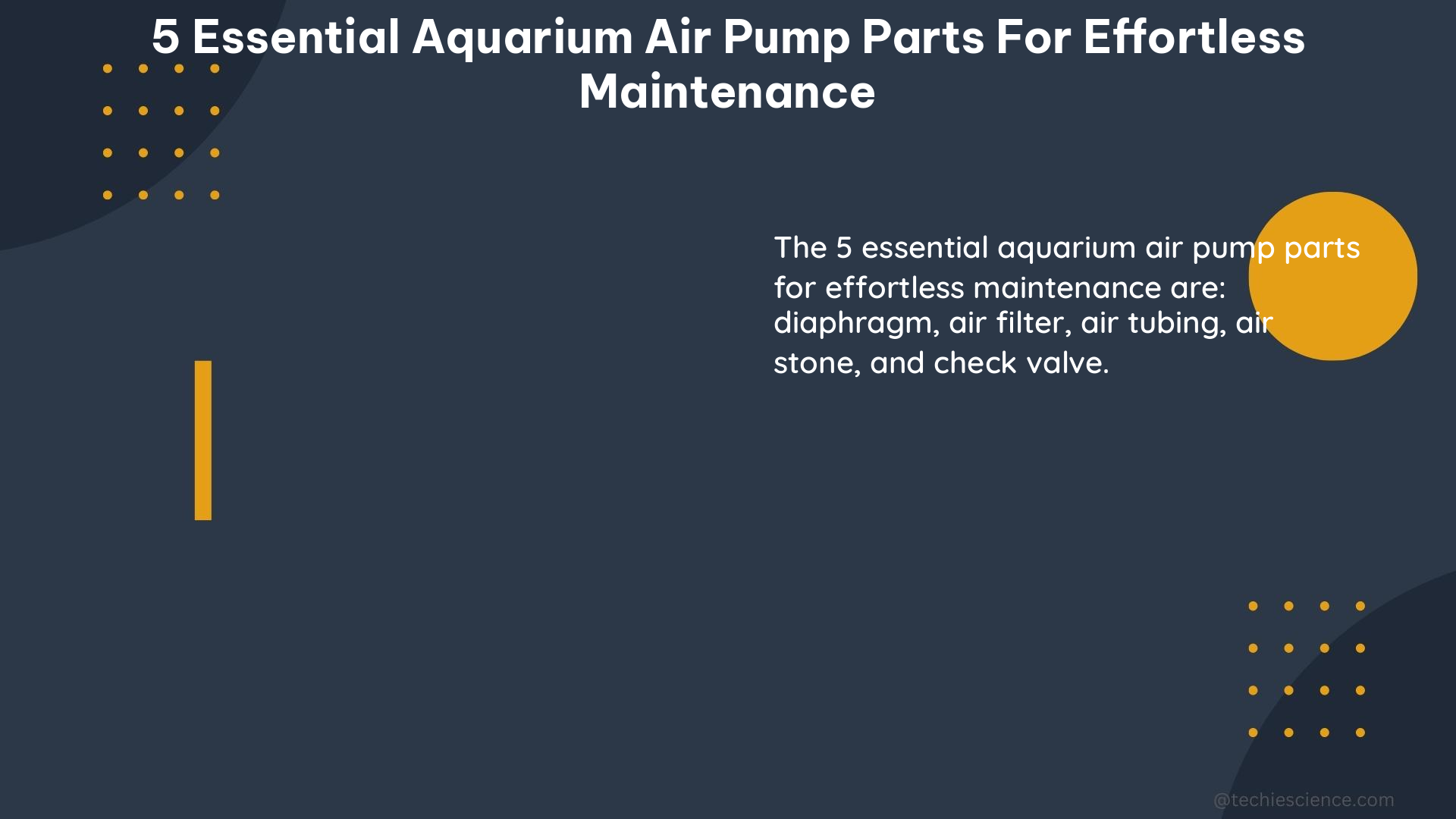Maintaining an aquarium air pump system is crucial for the health and well-being of your aquatic inhabitants. In this comprehensive guide, we’ll delve into the five essential aquarium air pump parts that you need to keep your system running smoothly and efficiently.
1. Air Pump
The air pump is the heart of your aquarium’s air circulation system. It is responsible for drawing in air and pushing it through the airline tubing to the air stone or other diffusers. The technical specifications of an air pump that you should consider include:
- Flow Rate: Measured in gallons per hour (GPH), the flow rate determines the volume of air the pump can deliver. For example, the EcoPlus Commercial Air 1 has a maximum output of 793 GPH, making it suitable for larger aquariums.
- Noise Level: Measured in decibels (dB), the noise level of an air pump can vary significantly. Quieter models, such as the EcoPlus Commercial Air 1, operate with minimal noise, ensuring a peaceful environment for your aquarium.
- Power Consumption: The power consumption of an air pump is an important factor, as it can impact your energy bills. Look for energy-efficient models that provide the necessary air flow without excessive power usage.
- Durability: The construction and materials used in the air pump can affect its lifespan. Opt for air pumps with a sturdy, corrosion-resistant design to ensure long-lasting performance.
2. Airline Tubing

The airline tubing is the flexible conduit that carries the air from the air pump to the air stone or other diffusers. When selecting airline tubing, consider the following technical specifications:
- Inner Diameter (ID): The ID of the tubing determines the volume of air it can accommodate. A common size for aquarium use is ¼ inch ID.
- Outer Diameter (OD): The OD of the tubing affects the fit and compatibility with other components, such as air pump outlets and air stone connectors. A typical size is 3/16 inch OD.
- Material: Airline tubing is typically made of flexible PVC or silicone. Silicone tubing is more durable and less prone to cracking or deterioration over time.
- Length: The length of the airline tubing should be sufficient to reach from the air pump to the desired location of the air stone or diffuser, with some extra length for flexibility.
3. Air Stone or Diffuser
The air stone or diffuser is the component responsible for breaking up the air into tiny bubbles, increasing the surface area for gas exchange. When selecting an air stone or diffuser, consider the following technical specifications:
- Pore Size: The pore size of the air stone or diffuser determines the size of the bubbles produced. Smaller pore sizes (0.5-1 mm) create finer bubbles, which are more effective for gas exchange.
- Flow Rate: The flow rate of the air stone or diffuser, measured in GPH, indicates the volume of air it can handle. A high-quality air stone may have a flow rate of 50-100 GPH.
- Material: Air stones are typically made of porous materials, such as ceramic or sintered glass, while diffusers may be made of plastic or metal.
- Size: The size of the air stone or diffuser should be appropriate for the size of your aquarium and the air pump’s flow rate.
4. Check Valve
The check valve is a one-way valve that prevents water from siphoning back into the air pump when the power is off. This is an essential component to protect your air pump from water damage. When selecting a check valve, consider the following technical specifications:
- Cracking Pressure: The cracking pressure, measured in pounds per square inch (psi), is the minimum pressure required to open the valve and allow air to flow. A high-quality check valve may have a cracking pressure of 0.5 psi.
- Flow Rate: The flow rate of the check valve, measured in GPH, should be compatible with the air pump’s output to ensure efficient air delivery.
- Material: Check valves are typically made of plastic or metal, with some models featuring a spring-loaded design for added durability.
- Size: The size of the check valve should match the diameter of the airline tubing to ensure a secure and leak-proof connection.
5. Air Pump Accessories
In addition to the core components, there are various air pump accessories that can enhance the performance and maintenance of your aquarium air pump system. These include:
- Air Pump Stands: These stands provide a stable and elevated platform for your air pump, preventing it from sitting directly on the floor or aquarium stand.
- Air Pump Covers: Covers help to muffle the noise generated by the air pump and protect it from dust and other environmental factors.
- Air Pump Cleaning Solutions: Specialized cleaning solutions can help remove buildup and maintain the efficiency of your air pump over time.
The technical specifications of these accessories may include their size, weight, material, and compatibility with your specific air pump model.
By understanding the essential components of an aquarium air pump system and their technical specifications, you can ensure effortless maintenance and optimal performance for your aquatic ecosystem. Remember to regularly inspect and maintain these parts to keep your aquarium thriving.
Reference:
- How to Fix Aquarium Air Pump EASY!!!! – YouTube
- 5 Best and Quietest Aquarium Air Pumps (60+ Tested!) – FishLab
- What Is an Aquarium Air Pump and Is It Necessary? – Freshwater Systems
